
Top view of shock showing the two chrome keepers
which hold the shock inside the bell cover and spring.
|
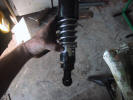
Side view showing bell cover, spring and shock
tensioner. |

My home-made shock compressor. Made with two 18"
pieces of ReadiRod, nuts and heavy fender washers, two 8" square
pieces of 3/4" plywood with a top hole of 2 & 1/2" and bottom hole
of 2 & 1/4". |

Just a "for comparison" shot. |
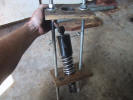
Loosen the nuts enough to drop the shock into
place... |
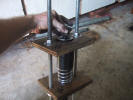
...use a wrench to alternately tighten the top 2 nuts
until you can pull the piston rod up enough to free the 2 keepers. |
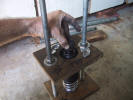
Remove keepers and clean them. Hold on to the piston
rod or put a screwdriver through the mounting hole as the shock is
now free to fall out. |

Slip the shock... |

...free and remove the tensioner ring and clean it
off. |
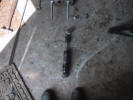
Clean off the shock and you are read to disassemble. |
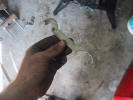
You will need this URAL shock tool or fab up one
yourself to get the top off the shock. People have used a punch and
hammer but this deforms the cap. |
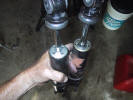
There are two styles of shock. One cap has 4 holes
where the other has 4 slots... |
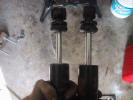
...the 4 hole type has a 12mm piston rod shaft while
the 4 slot shaft is 14mm. The internals are different and this will
be cover a little later. |
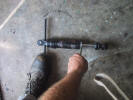
I just slip a piece of bar stock through the lower
shock stirrup and use the Ural shock tool to unscrew the cap. You
may need to slip a pipe extension over the wrench to break the cap
free. |

Once the cap is started off you can finish unscrewing
by hand... |
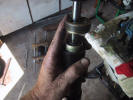
...with the cap free you can pull the piston... |
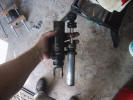
...out of the lower shock body which serves as the
oil reservoir. Be careful as the 12mm style piston body will
sometimes fall free on the rod. |
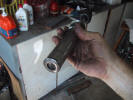
This is the 14mm style. Push the flapper valve on the
bottom in and work the piston rod to empty the oil inside. With the
12mm style you can just pull the piston body free to empty it. |
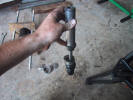
Unless you need to repair the innards, it is not
necessary to further disassemble the piston. Just clean all the
parts refill with oil and assemble. If you need to go farther, hold
the piston assembly upside down, use a hammer to tap around the edge
of the top cap (where my pinky finger is) to free the piston body
from the rod. |
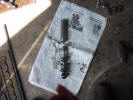
Piston body is now free of the rod assembly. |
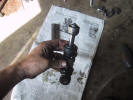
Use a 17mm wrench to remove the nut on the end of the
piston rod. |

Again, I use a screwdriver or bar stock to hold the
assembly while loosening the nut. |

Here are the bits and pieces of the 14mm style laid
out. Parts go on the piston rod from left to right. |
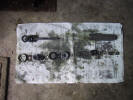
Here are the parts of the 12mm variety. |

When assembling, smack the piston body on a piece of
wood to press the top vent cap back into the piston body. Take care
not to pinch the O-ring gasket while doing this. |

Use a measure to pour 110 ml of what ever oil you
choose to use (I use 20w/50)... |
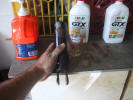
...into the shock outer body which is the oil
reservoir. When inserting the piston back into the shock, have the
piston rod fully depressed. |
Screw the cap down
until the threads are flush. Now work the piston up & down a couple
times to draw the oil up into the piston. This is messy so do it
over the oil catch and have rags ready. Finish by tightening the cap
with the URAL shock tool. Pump the rod some more...should go down
easy and be hard to pull out. Put the tensioner
ring back on the shock, insert it back into the compression tool,
slip the keepers above the rubber dough nut and release the nuts
compressing the shock. Reinstall the shock on the bike. |
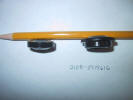
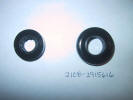
These are the two types of wiper seals that go bad
causing shock leaks. The left is the 12mm type and the right is the
14mm type. The 12mm type is available sparsely here in the U.S. from
some select URAL dealers. |
The 14mm type is a LADA car part and not
available here in the U.S. I have not found a source for them here.
The LADA part number is noted in the photo.
The 12mm type can be used on the 14mm style. Use silicone spray and
carefully install it onto the piston rod. It is a tight fit but does
work. |